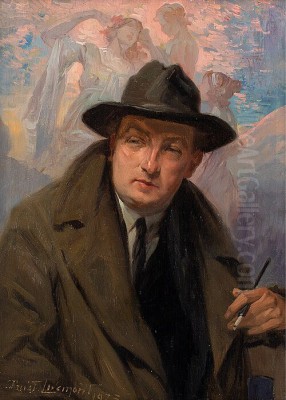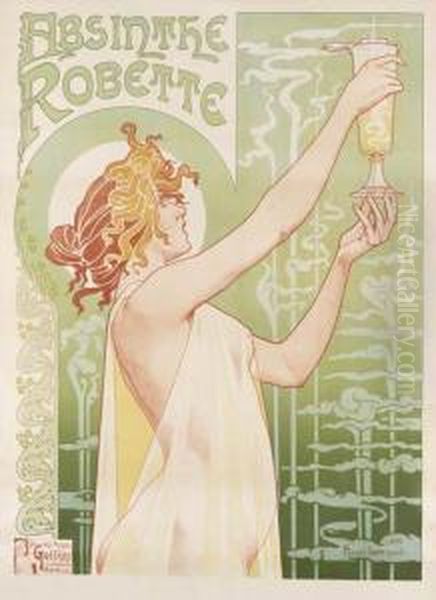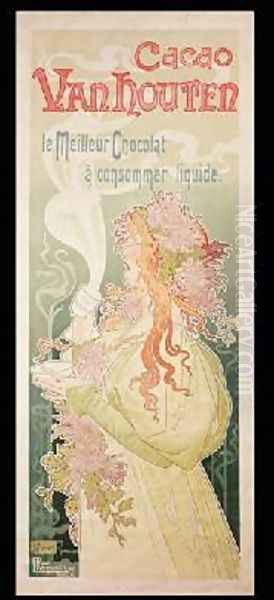
Henri Privat-Livemont (1861-1936) stands as a pivotal figure in the Art Nouveau movement, particularly celebrated for his exquisite poster designs and decorative art. A Belgian artist whose career flourished at the turn of the 20th century, Privat-Livemont's work is characterized by its elegant depiction of female figures, intricate floral motifs, and a masterful use of sinuous lines and harmonious color palettes. His contributions not only defined a significant aspect of Belgian Art Nouveau but also resonated across Europe, leaving an indelible mark on the visual culture of the era. This exploration delves into his life, artistic development, key works, and his enduring legacy within the rich tapestry of art history.
Early Life and Artistic Foundations
Born Henri Privat Antoine Théodore Livemont in Schaerbeek, a municipality of Brussels, Belgium, on October 9, 1861, the artist would later be known professionally as Privat-Livemont. His early artistic inclinations led him to pursue formal training in Brussels. He enrolled at the Académie Royale des Beaux-Arts, where he studied painting under esteemed instructors such as A. Bourson and Louis Hendrickx (sometimes cited as L.H. Hendrick). These formative years provided him with a strong academic grounding in drawing and painting, skills that would become foundational to his later, more stylized Art Nouveau creations.
The artistic environment of Brussels during this period was vibrant, with emerging trends challenging academic conventions. While Privat-Livemont received traditional training, the seeds of modernism and new artistic expressions were beginning to take root across Europe, and Brussels was becoming a significant hub for these developments. His early education would have exposed him to both the established classical traditions and the burgeoning desire for new forms of artistic expression, setting the stage for his later embrace of Art Nouveau.
Parisian Sojourn and Decorative Aspirations

Seeking to broaden his artistic horizons and immerse himself in one of the world's foremost artistic capitals, Privat-Livemont moved to Paris in 1883. This period, extending to 1889, was crucial for his development. In Paris, he continued his studies and gained practical experience by working in the studios of prominent decorative artists Lemaire, Lavastre & Duvignaud. These studios were renowned for their large-scale decorative projects, including work for theaters and public buildings.
During his time with Lemaire, Lavastre & Duvignaud, Privat-Livemont collaborated on significant decorative schemes. Notably, he contributed to the decorations for the Théâtre Français (Comédie-Française) and the Hôtel de Ville (City Hall) in Paris. This experience was invaluable, exposing him to the practical application of art in architectural settings and honing his skills in composition, color, and ornamental design on a grand scale. The emphasis on decorative harmony and the integration of art with architecture, prevalent in these Parisian studios, would profoundly influence his later Art Nouveau work, which often sought to beautify everyday life and public spaces.
Return to Brussels and the Ascent of a Poster Master
After his formative years in Paris, Privat-Livemont returned to Brussels around 1889. He brought with him a wealth of experience in decorative arts and a refined aesthetic sensibility. Brussels, at this time, was a fertile ground for Art Nouveau, with architects like Victor Horta and Paul Hankar pioneering the style in architecture and design. Privat-Livemont quickly established himself as a leading figure in the burgeoning movement, particularly in the realm of poster art and sgraffito, a decorative plaster technique.
His return coincided with a boom in advertising and the rise of the artistic poster. The streets of major European cities were becoming open-air galleries, and artists were increasingly commissioned to create visually striking advertisements. Privat-Livemont excelled in this medium, producing a series of iconic posters that captured the spirit of the age. He also became a respected teacher, sharing his knowledge and passion with a new generation of artists, further solidifying his influence within the Belgian art scene.
The Quintessence of Privat-Livemont's Art Nouveau Style
Privat-Livemont's artistic style is unmistakably Art Nouveau, yet it possesses distinct characteristics that set him apart. His work is renowned for its elegance, grace, and meticulous attention to detail. A central motif in his oeuvre is the idealized female figure, often depicted in profile or a gentle three-quarter view. These women are typically serene, ethereal, and adorned with flowing hair and elaborate, nature-inspired garments or accessories. They embody the "femme nouvelle" – the new woman – often associated with Art Nouveau, representing beauty, nature, and sometimes an enigmatic allure.

His compositions are characterized by sinuous, organic lines that undulate and curve, creating a sense of movement and fluidity. Floral and vegetal motifs are abundant, intricately woven into the design, framing the central figures or forming decorative borders. Privat-Livemont demonstrated a sophisticated understanding of color, employing subtle, harmonious palettes often featuring soft pastels, muted earth tones, and rich jewel-like accents. While often compared to his contemporary, the Czech artist Alphonse Mucha, Privat-Livemont's figures tend to be somewhat more realistic in their rendering, with a softer, more delicate quality, whereas Mucha's figures often possess a more stylized, iconic, and Byzantine-influenced grandeur. Both artists, however, shared a commitment to beauty and decorative richness.
Landmark Works: Posters and Decorative Panels
Privat-Livemont's reputation largely rests on his stunning poster designs, which became emblematic of Belgian Art Nouveau. Among his most celebrated works is the poster for "Absinthe Robette" (1896). This iconic image features an elegant woman with flowing auburn hair, holding a glass of the notorious green liqueur. The composition is a masterful blend of sensuous curves, delicate floral elements, and a sophisticated color scheme. The poster not only advertised the product but also encapsulated the mystique and allure associated with absinthe during the Belle Époque. It is considered a quintessential example of Art Nouveau poster art.
Another significant work is the poster for the "Casino de Cabourg" (1904). This piece depicts a graceful female swimmer, her form elegantly cutting through stylized waves, inviting viewers to the seaside resort. The dynamic lines and the harmonious integration of figure and environment showcase Privat-Livemont's skill in creating visually captivating and commercially effective designs. He also created notable posters for various products and events, including one for the Brussels World's Fair of 1897 (Exposition Internationale de Bruxelles), which further enhanced his international reputation. William Morris, a leading figure in the British Arts and Crafts movement, is said to have admired this particular poster.
Beyond posters, Privat-Livemont produced exquisite decorative panels. Works like "Roses Variées" (c. 1900) and "Majolique" (1901) demonstrate his versatility. These panels, often created using techniques like chromolithography or sgraffito, feature his characteristic female figures surrounded by lush floral arrangements, showcasing his deep appreciation for natural forms and his ability to translate them into elegant decorative compositions.
Sgraffito and Architectural Decoration
Privat-Livemont was also a master of sgraffito, a technique involving layering different colors of plaster and then scratching away parts of the upper layer to reveal the color beneath, creating intricate designs. This technique was particularly popular in Belgian Art Nouveau architecture, used to adorn building facades with durable and artistic ornamentation. Privat-Livemont created numerous sgraffito panels for buildings in Brussels and other Belgian cities, often collaborating with architects.
These sgraffito works, typically featuring his signature female figures, floral patterns, and symbolic motifs, contributed significantly to the aesthetic character of Art Nouveau architecture. They represented the movement's ideal of Gesamtkunstwerk (total work of art), where art and architecture were seamlessly integrated. His contributions in this field helped to beautify the urban landscape and solidify the visual identity of Belgian Art Nouveau. Architects like Victor Horta, Paul Hankar, and Ernest Blérot frequently incorporated sgraffito into their designs, and artists like Privat-Livemont were instrumental in executing these decorative elements.
The Controversial Allure: Absinthe and the Female Form
Privat-Livemont's work, particularly his "Absinthe Robette" poster, touched upon some of the social currents and controversies of his time. Absinthe, the potent, emerald-green spirit, was a popular but increasingly controversial beverage in late 19th-century Europe. It was associated with bohemian culture, artistic inspiration, and, increasingly, with addiction, madness, and social decay. Artists like Henri de Toulouse-Lautrec, Edgar Degas, and Édouard Manet had depicted absinthe drinkers in more somber, realistic, or critical ways.
Privat-Livemont's portrayal, however, presented absinthe in a more alluring and romanticized light. The elegant woman in his poster, sometimes interpreted as the "Green Fairy" (la fée verte) – a common personification of absinthe's intoxicating effects – seems to offer the drink as a source of pleasure or inspiration rather than a path to ruin. This idealized depiction contrasted sharply with the growing public concern over absinthe's dangers, which eventually led to its ban in several countries.
Furthermore, the depiction of women in Art Nouveau, while often celebrating beauty and grace, also sometimes faced criticism for its perceived sensuality or for objectifying the female form. Privat-Livemont's elegant and often ethereal women generally avoided overt eroticism, yet they were undeniably central to the visual appeal of his commercial works, tapping into contemporary ideals of feminine beauty to sell products and experiences. His style, while widely admired, was part of a broader artistic trend whose representation of women and controversial subjects like absinthe could spark debate.
Privat-Livemont and His Contemporaries
Henri Privat-Livemont was part of a vibrant international community of artists who defined the Art Nouveau era. His most direct counterpart in terms of style and subject matter in poster art was undoubtedly Alphonse Mucha. Both artists excelled in depicting graceful women, intricate floral patterns, and flowing lines. However, as noted, Mucha's style often incorporated more complex symbolism, Byzantine-inspired halos, and a more monumental quality, while Privat-Livemont's work tended towards a softer, more naturalistic elegance.
In France, the pioneers of artistic poster design, Jules Chéret and Henri de Toulouse-Lautrec, were highly influential. Chéret, often called the "father of the modern poster," created vibrant, joyful images of Parisian life, while Toulouse-Lautrec brought a grittier, more psychologically incisive approach to his depictions of Montmartre's nightlife. Other notable French Art Nouveau artists include Eugène Grasset, whose style was more medievally inspired, and Théophile Steinlen, known for his iconic "Le Chat Noir" poster and his socially conscious illustrations. Georges de Feure was another contemporary whose work often featured delicate, ethereal female figures.
In Belgium, Privat-Livemont was a key figure alongside architects like Victor Horta and Paul Hankar, who were instrumental in defining Art Nouveau architecture. Other Belgian artists contributing to the movement included Fernand Khnopff and James Ensor, though their styles often veered more towards Symbolism.
Across Europe, Art Nouveau manifested in various forms. In Vienna, the Secession movement, led by Gustav Klimt, shared Art Nouveau's decorative impulse but with a distinct Viennese flavor. In Britain, artists like Aubrey Beardsley developed a highly stylized, often decadent, linear style, while the Arts and Crafts movement, championed by William Morris, emphasized craftsmanship and nature, influencing Art Nouveau's principles. In the Netherlands, Jan Toorop created distinctive Symbolist and Art Nouveau works. The influence of Japanese art (Japonisme) was also a common thread, evident in the flattened perspectives, asymmetrical compositions, and decorative motifs seen in the work of many Art Nouveau artists, including Privat-Livemont. The American artist Louis Comfort Tiffany became renowned for his Art Nouveau glasswork, further illustrating the international reach and multidisciplinary nature of the style.
Privat-Livemont's relationship with these contemporaries was one of shared artistic exploration within the broader Art Nouveau ethos. While there was undoubtedly competition, particularly in the commercial realm of poster design, there was also a collective sense of participating in a new, modern artistic language that sought to break from past conventions and infuse art into everyday life.
Teaching and Later Career
Beyond his prolific output as a designer and decorator, Privat-Livemont was also a dedicated educator. He taught at the School of Industrial Arts in Schaerbeek, his hometown. His role as a teacher allowed him to pass on his skills and aesthetic principles to a new generation of artists and designers, contributing to the continuity and evolution of decorative arts in Belgium.
As the Art Nouveau style began to wane in popularity after its peak around 1900, giving way to Art Deco and other modernist movements in the lead-up to and aftermath of World War I, Privat-Livemont continued to work. While his style remained rooted in the Art Nouveau aesthetic that had brought him fame, he adapted to changing tastes to some extent. He continued to produce decorative work and paintings, though perhaps with less of the widespread public acclaim he had enjoyed at the height of the Art Nouveau craze. He passed away in Schaerbeek on October 4, 1936.
Legacy and Art Historical Evaluation
Henri Privat-Livemont is remembered as one of the most accomplished and distinctive artists of the Belgian Art Nouveau movement. His posters, in particular, are highly prized by collectors and are frequently exhibited as prime examples of the era's graphic design. Works like "Absinthe Robette" have achieved iconic status, transcending their original commercial purpose to become enduring symbols of Belle Époque aesthetics.
His mastery of line, color, and composition, combined with his elegant portrayal of the female form and his intricate use of natural motifs, places him firmly in the pantheon of great Art Nouveau designers. He successfully bridged the gap between fine art and commercial art, demonstrating that advertising could be a medium for genuine artistic expression. His contributions to sgraffito decoration also played a vital role in shaping the visual character of Belgian Art Nouveau architecture.
While perhaps not as universally recognized today as Alphonse Mucha, Privat-Livemont's influence was significant, particularly within Belgium and among connoisseurs of poster art. His work exemplifies the Art Nouveau ideal of bringing beauty and artistic quality to everyday objects and public spaces. He helped to define a uniquely Belgian iteration of the Art Nouveau style, characterized by its grace, refinement, and decorative richness. His legacy endures in the continued appreciation for his art and in the recognition of his role in a transformative period of art and design history.
Conclusion
Henri Privat-Livemont was more than just a skilled craftsman; he was an artist who captured the zeitgeist of the Fin de Siècle. His elegant women, swirling floral patterns, and harmonious designs epitomized the Art Nouveau aspiration to create a new visual language for a modern age. From the vibrant streets adorned with his posters to the facades embellished with his sgraffito, Privat-Livemont's art infused beauty into the fabric of daily life. As a key proponent of Belgian Art Nouveau, his work remains a testament to the era's optimism, its embrace of nature, and its pursuit of aesthetic refinement, securing his place as a distinguished master of this enchanting artistic movement.